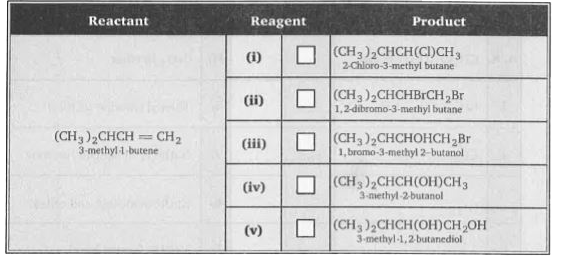
Sum P + Q + R is : Solution in Kannada
The correct Answer is:P + Q + R = 10
Topper's Solved these Questions
- BOOK - MS CHOUHANCHAPTER - HYDROCARBONS (ALKANES) EXERCISE - LEVEL - 2 (2. COMPREHENSION)7videos
HYDROCARBONS (ALKANES)
- BOOK - MS CHOUHANCHAPTER - GRIGNARD REAGENTEXERCISE - Level-2 (Subjective Problems)6videos
GRIGNARD REAGENT
- BOOK - MS CHOUHANCHAPTER - HYDROCARBONS (ALKENES)EXERCISE - LEVEL-222videos
HYDROCARBONS (ALKENES)
Similar Questions
Halogenation is a substitution reaction, where halogen replaces one or more hydrogens of hydrocarbon.

Chlorine free radical make 1∘,2∘,3∘ radicals with almost equal ease, whereas bromine free radicals have a clear preference for the formation of tertiary free radicals. So, bromine is less reactive, and more slective whereas chlorine is less selective and more reactive.
The relative rate of abstraction of hydrogen by Br is
3∘>2∘>1∘(1600)(82)(1)
The relative rate of abstraction of hydrogen by Cl is
3∘>2∘>1∘(5)(3.8)(1)
1-halo-2, 3-dimethyl butane will be obtained in better yields, if halogen is :03:51View Solution
How many geometrical isomer of (X) is possible ?08:09View Solution
In each reagent box write a letter designating the best reagent and condition selected from the above list of reagents.
 08:14View Solution
08:14View SolutionSum of the first p, q and r terms of an A.P are a, b and c, respectively.Prove that ap(q−r)+bq(r−p)+cr(p−q)=0
06:49View SolutionThe sum of the first p, q, r terms of an A.P are a, b, c respectively. Show that ap[q−r]+bq[r−p]+cr[p−q]=0
06:33View SolutionThe sum of the first p,q,r terms of an A.P. are a,b,c respectively. Show that ap(q−r)+bq(r−p)+cr(p−q)=0
08:08View SolutionThe sum of first p,q and r terms of an AP are a, b and c respectively. Show that aq−rp+br−pq+cp−qr=0
03:52View Solutionयदि किसी समान्तर श्रेढ़ी के प्रथम p , q , r पदों का योगफल क्रमशः a , b तथा c हो तो सिद्ध कीजिए कि
ap(q−r)+bq(r−p)+cr(p−q)=009:09View SolutionIf a, b, c be respectively the sums of p, q, r terms of an A.P., show that,
ap(q−r)+bq(r−p)+cr(p−q)=012:11View SolutionIf a,b,c be respectively the sum of first p,q,r terms of an A.P. then ap(q−r)+bq(r−p)+cr(p−q) equals :
03:44View SolutionThe sum of the first p,q,r terms of an A.P. are a,b,c respectively. Show that ap(q−r)+bq(r−p)+cr(p−q)=0
04:10View SolutionThe sum of the first p,q,r terms of an A.P. are a,b,c respectively. Show that ap(q−r)+bq(r−p)+cr(p−q)=0
08:32View SolutionThe sum of the first p,q,r terms of an A.P. are a,b,c respectively. Show that ap(q−r)+bq(r−p)+cr(p−q)=0
07:05View SolutionThe sum of first p,q and r terms of an AP are a,b and c respectively . Show that ap(q−r)+bq(r−p)+cr(p−q)=0
05:29View SolutionThe sum of the first p,q,r terms of an AP are a,b,c respectively, prove that
ap(q−r)+bq(r−p)+cr(p−q)=010:53View SolutionIf a,b,c are respectively the sums of p,q,r terms of an A.P., prove that ap(q−r)+bq(r−p)+cr(p−q)=0
07:48View Solution


